本文档将讨论如何使用 JavaScript 定义代码块中的输入和字段(包括标签)。如果您不熟悉这些术语,请先参阅块的结构,然后再继续。
您还可以以 JSON 格式定义输入、字段和连接。
附加输入
JavaScript API 针对每种输入类型都包含一个 append 方法:
JavaScript
init: function() {
// ...
this.appendEndRowInput()
.appendField('for each')
.appendField('item')
.appendField(new Blockly.FieldVariable(), 'VAR');
this.appendValueInput('LIST')
.setCheck('Array')
.setAlign(Blockly.inputs.Align.RIGHT)
.appendField('in list');
this.appendStatementInput('DO')
.appendField('do');
this.appendDummyInput()
.appendField('end');
}

每个 appendInput 方法都可以接受一个标识符字符串,代码生成器使用该字符串来检索与输入连接的块的代码。代码生成器很少引用虚拟输入和行尾输入,因此通常没有理由为其分配标识符。
JavaScript API 还包含一个用于附加自定义输入的通用 appendInput 方法。请注意,在这种情况下,标识符应直接传递给自定义输入的构造函数。
JavaScript
init: function() {
// ...
this.appendInput(new MyCustomInput('INPUT_NAME'))
.appendField('an example label')
}
所有 appendInput 方法(包括泛型和非泛型)都会返回输入对象,以便可以使用方法链进一步配置这些对象。有三种用于配置输入的内置方法。
附加字段
创建输入并使用 appendInput 将其附加到块后,可以选择性地将任意数量的字段附加到输入。这些字段通常用作标签,用于描述每个输入的用途。
JavaScript
init: function() {
// ...
this.appendDummyInput()
.appendField('hello');
}

最简单的字段是标签。Blockly 的惯例是使用全小写文本,专有名词(例如 Google、SQL)除外。
输入行可以包含任意数量的字段。多个 appendField 调用可以链接在一起,以便高效地向同一输入行添加多个字段。
JavaScript
init: function() {
// ...
this.appendDummyInput()
.appendField('hello')
.appendField(new Blockly.FieldLabel('Neil', 'person'));
}

appendField('hello') 调用实际上是使用显式 FieldLabel 构造函数(即 appendField(new Blockly.FieldLabel('hello')))的快捷方式。只有在指定类名时,才需要使用构造函数,这样才能使用 CSS 规则设置标签的样式。
连接检查
JavaScript
init: function() {
// ...
this.appendValueInput('NUM')
.setCheck('Number');
}
setCheck 方法用于检查连接的类型。如果给定实参为 null(默认值),则此输入可连接到任何块。如需了解详情,请参阅连接检查。
对齐字段
JavaScript
init: function() {
// ...
this.appendValueInput('LIST')
.appendField('in list')
.setAlign(Blockly.inputs.Align.RIGHT);
}
setAlign 方法用于对齐输入中的字段。有三个自描述值可作为实参传递给此函数:Blockly.inputs.Align.LEFT、Blockly.inputs.Align.RIGHT 和 Blockly.inputs.Align.CENTER。
当块以从右到左的模式(例如阿拉伯语和希伯来语)呈现时,左侧和右侧会反转。因此,Blockly.inputs.Align.RIGHT 会将字段向左对齐。

